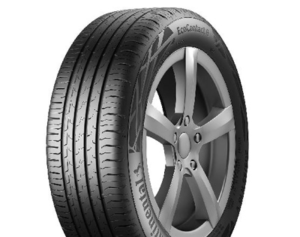Continental’s EcoContact developed with significantly improved rolling resistance
Hanover, Germany – Continental has developed a tire with a significantly improved rolling resistance for Peugeot, DS and Opel vehicles with electric drive and combustion engine. All electric SUVs Peugeot e-2008, the Opel MOKKA-E and the all-electric DS 3 Crossback E-TENSE, as well as all combustion engine versions of these models will be factory-equipped with the 17-inch tire. The tire is based on a Continental EcoContact 6 (215/60 R17 96H). Its energy efficiency classification exceeds the EU tire label value A requirements by around 17 percent, which means it has a particularly low rolling resistance. It has also received the top EU tire label rating A for wet grip. This development achievement by Continental’s tire engineers and materials experts is all the more remarkable since the reduction of rolling resistance and exceptionally high braking performance are conflicting physical targets. While driving, energy loss should be kept as low as possible to minimize rolling resistance. However, the opposite is true for braking: To keep braking distance to a minimum, tires need to dissipate as much energy as possible. The improvements were achieved thanks to a new sidewall structure and a special rubber compound for the tread.
“We developed a tire with outstanding properties for Stellantis, and it received top marks for rolling resistance and wet braking performance. We achieved these properties through a new sidewall concept and a special rubber compound for the tread. Our experts have once again pushed the physical boundaries for greater safety and efficiency on the road,” says Dr. Holger Lange, heading the tire development for Continental’s original equipment business.
In the context of the new sidewall concept, the engineers also refined the use of various high-performance compounds during development and production. For example, an additional compound inside the sidewall creates less rolling resistance. A second compound ensures that the outer tire sidewall remains tough enough to withstand everyday situations in road traffic and environmental influences such as curb contact and UV radiation. The third compound is designed to ensure the robustness of the tire in the rim area.
Rolling resistance optimization plays a major role in tire development, especially for electric vehicles. After all, a reduced rolling resistance has a measurable and positive effect on the environment. It also helps reduce the energy consumption of a vehicle, increasing the range of electric vehicles by three to four percent. Confirmed by leading vehicle manufacturers, Continental’s internal calculations conclude that a 15 percent reduction in rolling resistance for an internal combustion engine (all other conditions being equal) can achieve fuel savings of around 0.1 liters per 100 kilometers. This results in a reduction in CO2 emissions of approximately two grams of CO2 per kilometer.
Carmakers throughout the world rely on Continental as a leading tire manufacturer. Almost every third vehicle in Europe comes off the production line with Continental tires. Continental supplies six of the world’s ten most successful manufacturers of electric vehicles with tires ex-works. Continental’s tire replacement business also offers a wide range of summer, winter and all-season tires for Stellantis electric and combustion vehicles, including many tire test winners.
The EcoContact 6 215/60 R17 96H has been factory-approved in many countries for the Peugeot e-2008, the Opel MOKKA-E and the DS 3 Crossback E-TENSE and their internal combustion engine versions.

